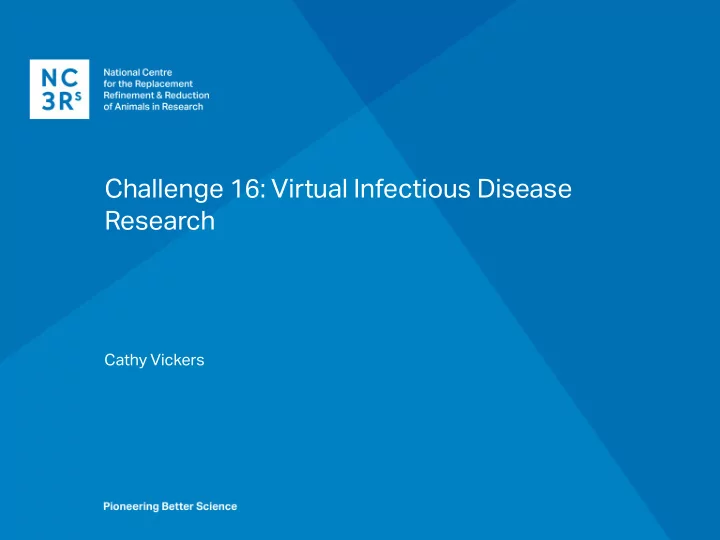

Challenge 16: Virtual Infectious Disease Research Cathy Vickers
Phase II Attrition rates Arrowsmith & Miller, Nature Reviews Drug Discovery 12, 569 (2013)
Citation: CPT: Pharmacometrics & Systems Pharmacology (2013) 2, e40;
Infectious Disease Research and the 3Rs Animal use in a typical rodent efficacy study for new antibiotics or vaccines can involve approximately 100 animals per candidate The animals are infected with the pathogen after vaccination or treated with the drug of interest Untreated controls are always used. The resulting disease in control animals and those in whom the vaccine or drug are ineffective, can cause severe suffering The use of in silico approaches to study disease biology and predict efficacy would reduce the number of animals used Reducing the number of animals used AND reducing attrition
The Virtual Infectious Disease Research Challenge To develop a virtual platform that models infection and the host response to pathogen assault for basic research and enhances new target development in infectious diseases.
Challenge Details : Phase 1 Key deliverables Identify chosen host and pathogen on an evidence basis with justification and scientific merit along with projected 3Rs impact Propose infrastructure for the platform outlining the integration of animal based evidence and literature with a mathematical and computational approach Demonstrate the level of predictivity of the system, including the limitations Develop a simple prototype of how the information will be assimilated and presented to the user Provide a strategy for validation of the model in Phase 2 including key criteria that will define success Provide evidence of collaborative expertise, including wet scientists, to progress into Phase 2 Consideration of a suitable business model to disseminate the platform including potential market
Challenge Details : Phase 2 The successful Phase 2 candidate will have delivered a proof-of- concept model for their chosen pathogen and host during Phase 1. Certain deliverables will be influenced by the Phase 1 outcome, but the common requirements will be: The delivery of a virtual platform, including predictive tools, quantitative techniques and mathematical models that will describe and predict the spread of infection and the host response for a single, or combination of, pathogens And/or A model to determine how vaccines or adjuvants influence the host response
Challenge Details : Phase 2 The model should be able to: Predict/ biology of the pathogen in the host Detail the internal microbial processes of the pathogen Track the dissemination of the pathogen within the host Describe the interaction of the pathogen with the host immune system Identify new and improved diagnostic and therapeutic targets. There should also be the capability to detect and test novel responses associated with resistance.
Challenge Details : Phase 2 The project management team should provide evidence of: Consultation with industry and academic experts in this area to access the data sets needed to deliver the brief The needs and market of the end user The consortia should deliver: A system that will be taken up across all areas in the bioscience sector Strategy for commercialisation and uptake
Points to consider: What we don’t want are models for measuring the spread of pathogens through populations Relevance to human health 3Rs impact Choice of pathogen, host, model of resistance Focus of your application: can it all be done? single host / multiple pathogens? Skills sets: network for expertise outside your area- mathematics, biology
Thank you
Recommend
More recommend